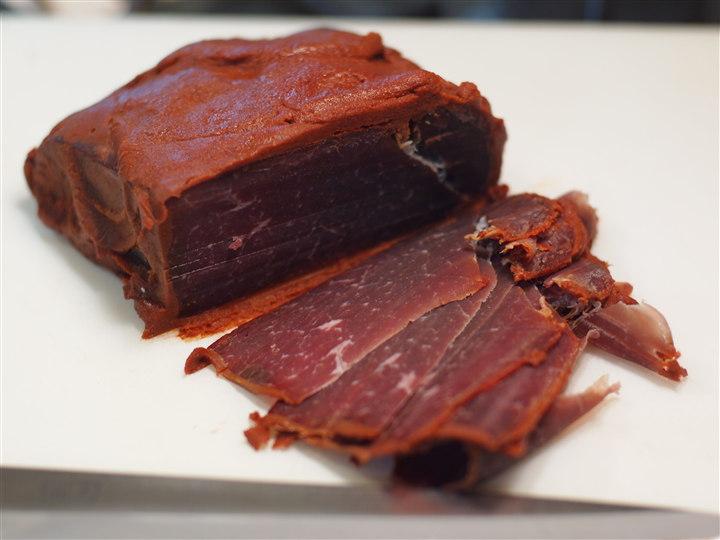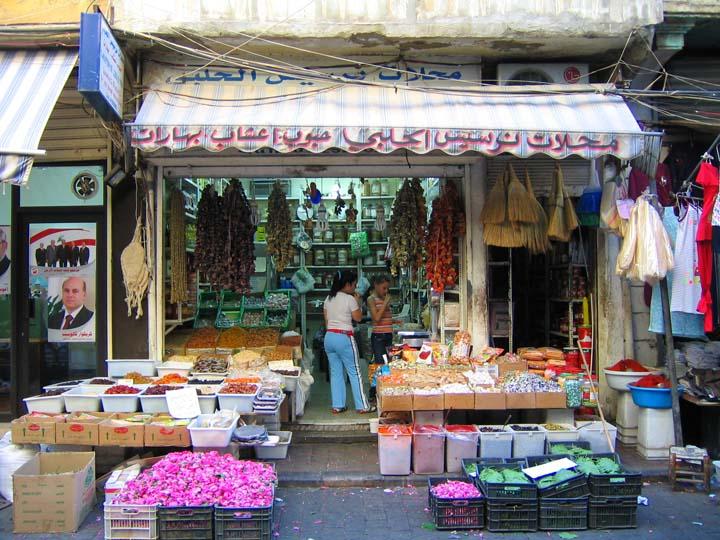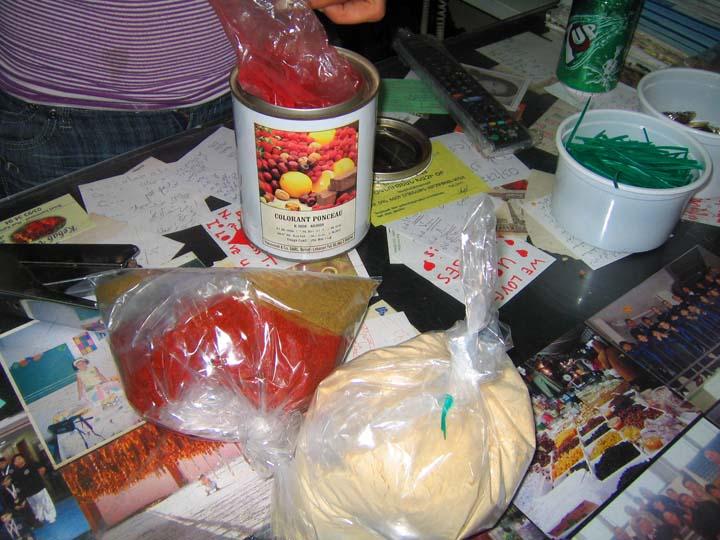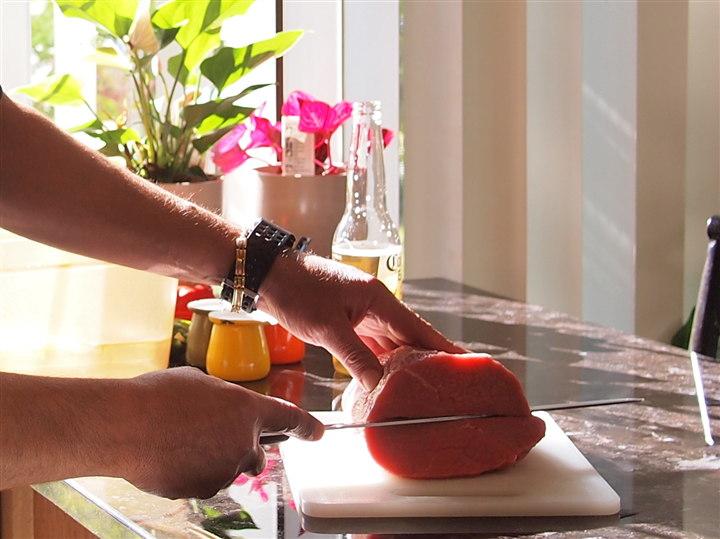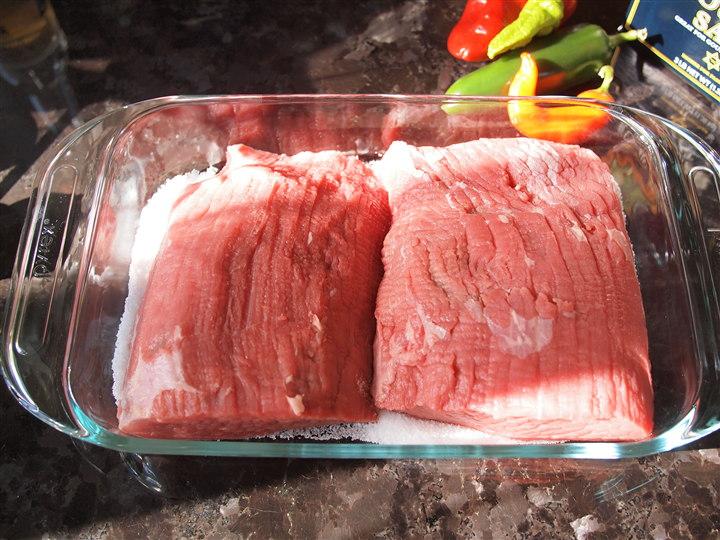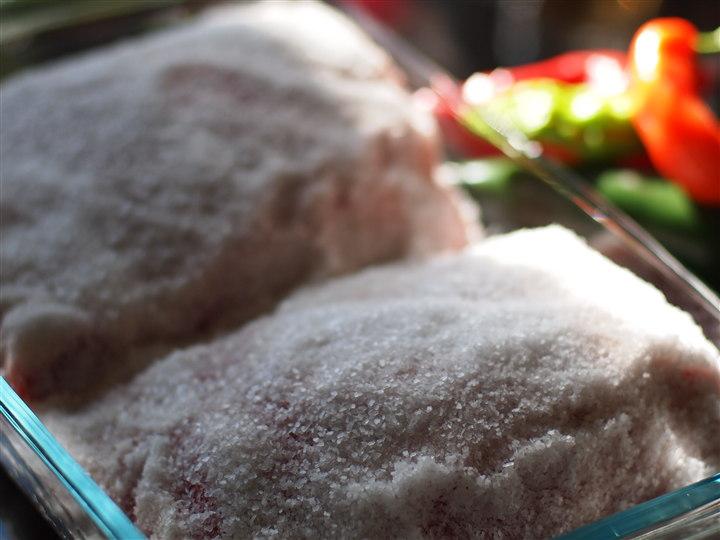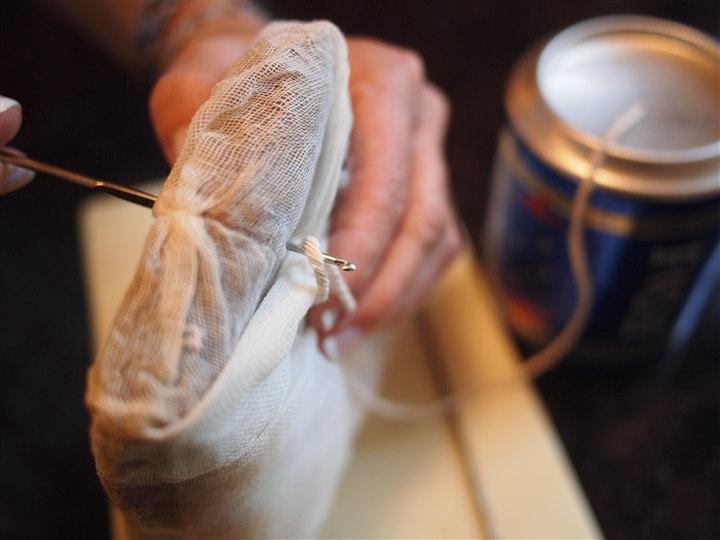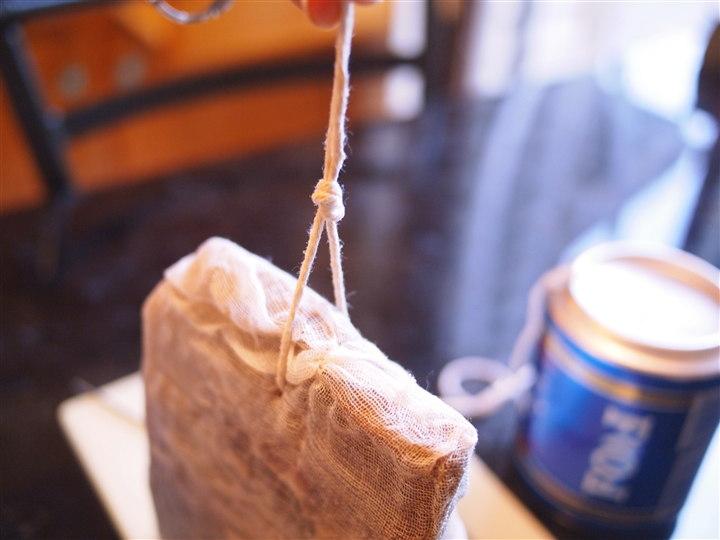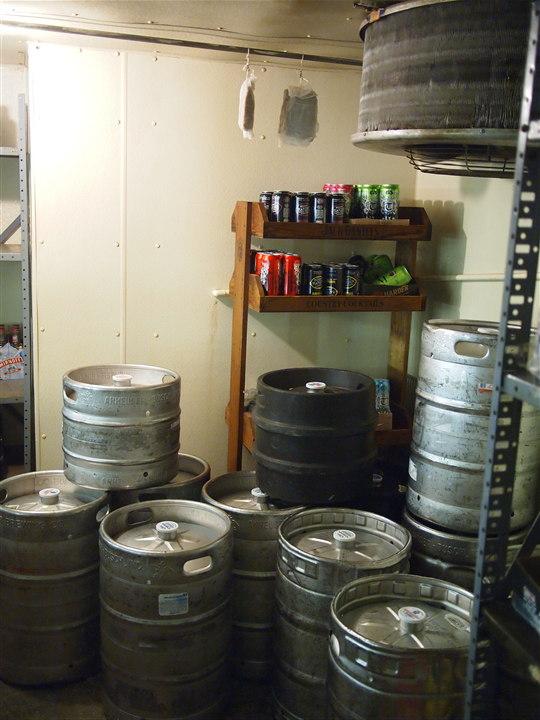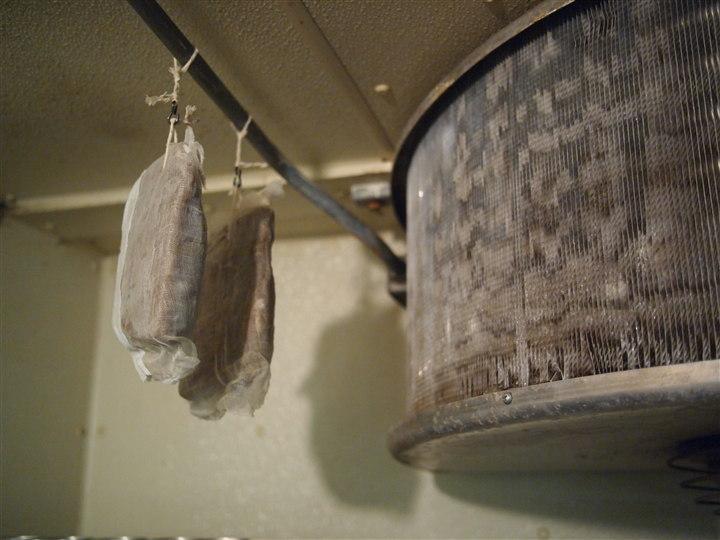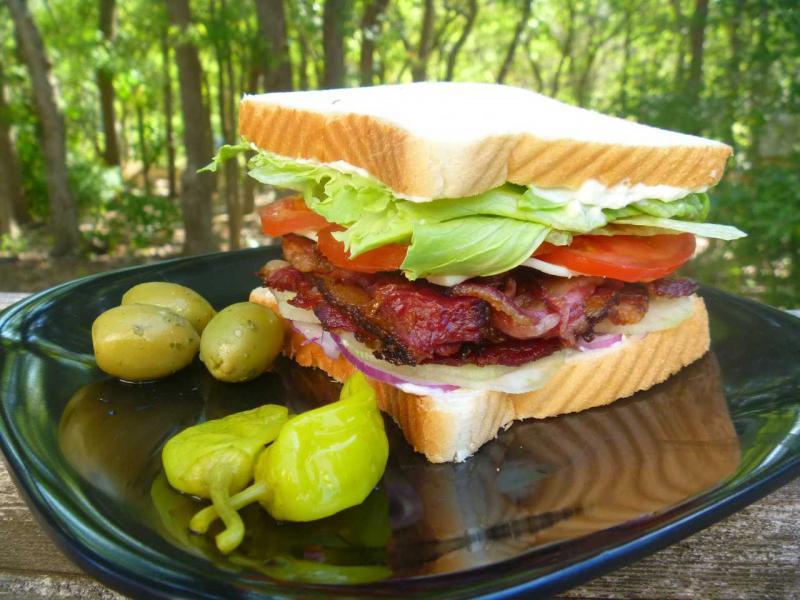Search the Community
Showing results for tags 'Charcuterie'.
-
I'm sure this matter has been discussed in part or whole somewhere on egullet, but after 20 minutes of various searches I sure can't find it! ]So, thanks for a pointer if you know of a previous thread. In short, I recently cut down a coppa I made and the end product ended up having too salty a taste. I've made this recipe several times with great success. This time, I'm positive the extra saltiness has to do with the fact that, due to an personal emergency, it had to spend too much time in the salt cure before it was hung (as in over a week extra). This raises a few questions for me about procedures and troubleshooting. 1. First, obviously, any suggestions for an after-the-fact how to rectify this too-salty coppa? Of course, I could chop it up and mix it into some sort of cooked dishes, but in this case, I'm specifically curious about ideas to rescue it to make it more palatable to eat on it's own. I'm open to experimentation. 2. Given that I knew that it had spent too long in the cure, what would have you advised that I had done previous to air curing? I gave it a good vinegar and water washing and about a 1 hour cold water bath before hanging. 3. Can a too-salty result be the result of too much salt in the cure? I wouldn't think so, but now I'm curious. It's been my experience that the amount of salt is less of an issue than the length of time it spends curing. I've always relied on visual cues and firmness. Thanks for any ideas.
-
We all know you can brine a bird, smoke a turkey, etc... I am looking for info on preserving turkey & chicken through a curing process. The googlenet has suprisingly little info on the subject. Any knowledge would be appreciated.
-
Sorry if this has been written about so far, but I looked and could not find it. I am about to make a large bit of Duck Confit, and curious what is the process to can (in a jars) the confit. I read the Duck Confit thread, and the writer stated you could jar them and it would last, but it was light in detail since that was not the actual topic he was writing about. I am finding it hard to find actual information on the web or in preserving books to actually preserving the cofit. Here are my questions if anyone can help.... 1. How long do i boil the jars to ensure everything is sterile. ( i plan on using the smallest Ball jars ) 2. Can I keep the preserved confit in a basement or cool place versus in the fridge. My point in preserving this is to keep from the fridge. 3. Any idea how long it will last, or i guess how long until the layer of duck fat on the top will last before it spoils/goes rancid ? 4. Can i use a water bath (sous vide or without bag) to heat the jars? I do not have a pressure cooker but do have a Polyscience Immersion Circulator. 5. If yes on the Polyscience Immersion Circulator, any idea on temp etc. Any luck with bags or no bags? Thanks for any help !
-
I found a link here, on egullet, for a recipe of pancetta. I was amused by the sentence at the bottom "pancetta is not meant to be eaten uncooked". Is it just cultural? I grew up eating it. In my university cafeteria in Milan, it was the cheapest panino on sale, only 1,000 lire at the time. Nice and comforting for me a panino with pancetta dolce (the fattier pancetta). So, why not eating it raw? And lardo?
-
I am looking for good online collections of sausage/bacon/ham recipes and reviews on the quality of the recipes. So far I've located: Jason Molinari's excellent blog: http://curedmeats.blogspot.com/ Len Poli's Collection: http://lpoli.50webs.com/Sausage%20recipes.htm The Spicy Sausage: http://thespicysausage.com/sausagemakingrecipes.htm
-
Hello all - for the 99.99% of you who do not live in the NY Finger Lakes region, this may be a bore. However, this posting is directed toward that handful who are "local," and the somewhat larger handful of eG people who don't live near here, but who have kitchen friends who do. I've just started a new Meetup.com group, named "Offal Majesty." I hope it to become a cooks' group specializing in producing dishes based on the so-called "variety meats," and in the cooperative production of charcuterie - muscle meat based, or offal based. Sometimes our meetings will finish with a participants' dinner; other times we'll just split up what we've made and take the product home for curing, or for sharing with family and friends. To find out more, please check out the group's website on Meetup.com. If you think you might know potential members ("Cooks with guts"), please forward the group's URL to them. Tanx, Paul Host Note: Please click here for the terms under which this announcement has been posted.
-
After a few years making fresh sausages and occasional dry-cured whole cuts (e.g. pancetta, guanciale), I finally have the space to do some dry-cured sausages, so I hung my first ones up in my basement on Monday. I did a split batch of two recipes from Ruhlman/Polcyn's Charcuterie, the tuscan salami and a variation on the spanish chorizo. The sausages looked good, I pricked them with a needle to get rid of air bubbles, and I placed them into a warm spot overnight to incubate the lactic acid starter. Unfortunately, it got a bit warmer than I expected in there - about 95 degrees F - but that still seemed to be within the starter culture's acceptable range (up to 100). The sausages looked fine, but had wept a small amount of liquid fat, which surprised and slightly concerned me. Since then I've had them hanging in a basement at about 60-65 F and 60% RH. They continue to drip fat consistently, the chorizo a bit more than the salumi. Any thoughts? I'm obviously going to let them dry and see how it goes, but I'm curious what's going on here, and whether it's normal or not. I haven't really found any references to this in any text or on the internet. Many thanks in advance.
-
We recently moved to rural Virginia, and have found a local farmer selling whole pastured hogs and we are buying one, about 400# on the hoof. They will deliver to a closely USDA approved butcher, and I could use some suggestions as to how to instruct the butcher, and any good resources online, so I can get the most out of the pig. In addition to the major cuts, I'm planning to ask for the extra fat, the caul fat, soup bones, probably some skin, and for all the scraps to be packaged in pieces rather than ground, so I can grind it myself for sausage. Any other tips? And good ideas for things to do with pig organ meats? Is it worth taking the head or should I just stick with the jowls (hubby is a bit squeamish about the head)? Thanks!
-
An Armenian, Turkish, Russian cured cut of meat. Usually made from beef, it's cured, dried and coated with a highly spiced mixture called Chemen. This is a piece I bought at Bedo's in Burj Hammoud (a neighborhood with a large Armenian community). While in Beirut this past summer, I got a basturma recipe straight from an Armenian grandmother. I was even told where to buy the ingredients in Burj Hammoud. The stuff in the can is a red food coloring. While most recipes call for the fillet, I decided to go with an eye of round. This was about 4lbs and I sliced it in half to end up with 2 thinner pieces. I laid the pieces on a bed of kosher salt and covered them with more. I placed them in the fridge for 4 days. The pan was drained every day, I'd say the meat lost about 3 pints of liquid. This is what they look like on the last day. As per the instructions, the meat was rinsed and soaked in water for 1 hour. The slabs were dried and wrapped with cheese cloth and pressed between two cutting boards in the fridge for 2 days. To my surprise there was no liquid released after the pressing. In fact the cheese cloth was barely damp. The meat was pretty firm. I had skipped the step in which I was supposed to insert a twine through the narrow (thin) end of the meat to hang them with. Here my wife had a clever idea. She used a crochet needle to poke through and retrieve the twine. I wasn't about to hang these outside so I took them to work and hung them in a keg cooler. Directly in the air flow from the evaporator. They hung for 15 days. Next: Making the Chemen and coating the meat.
-
I tried Fromagerie Atwater to no avail... any other ideas to source italian lardo?
-
So I want to do a Dr Pepper brine on some gorgeous pork belly I was lucky enough to find today. I'm thinking garlic, chilies, thyme and Dr Pepper syrup, but I'm worried that with a 3-4 day brine, the phosphoric acid in the syrup is going to mangle the meat. Any ideas? Should I just do a standard brine, and the a short dry cure with the syrup? I'm sort of at a loss on this one.
-
Having spent a good bit of the last year learning to make sausages, I have some questions about how things were done before modern conveniences were available. 1) I've had a few broken forcemeats because my ingredients got too hot. How did people avoid this problem before the ubiquity of ice and refrigeration? 2) Since curing requires fairly narrow bands of humidity and temp, how did people control these variables before electricity? I understand that basements and caves were employed but I've found that a basement is often insufficient (at least mine is). With the broad occurence of sausage production across vastly different climates, it would seem that in some places basements wouldn't be enough.
-
Hi, I've looked around for an answer for this question and I can't seem to find one. It's my first post in this forum, having hovered around for a while, so please be gentle with me I've finally started making my own pancetta recently, with inspiration from here. I've been using a pre-blended curing mix that I bought online at sausage making.org. The result tastes just fine but I need to work on my meat trussing skills ! I now have a reasonable supply in my fridge and freezer so won't be making any more for a few months at least. I was wondering what to do with the rest of the cure blend I have sitting in my cupboard. Could I use my cure mixture to corn some beef brisket that I have in the freezer, or should I simply buy a bespoke cure for my brisket and save the other mix for when I finally run out of pancetta? If it's ok to go with the the mix can I just add the other ingredients like coriander and the like?
-
I have a bunch of carbon steel meat grinder plates, which I despise: I have no idea how one can actually keep the damned things rust-free, they seem to oxidize in the time it takes me to dry them. I just got a catalog from sausagemaker.com in the mail, and it seems they sell a wide range of stainless steel grinder plates. Has anyone tried them, and are there other sources out there I don't know about?
-
This sandwich took me a few days to make but it was well worth it. Plus I have enough lamb bacon left to make another 8 or 10 of these. And plenty of lamb bacon fat for whatever tickles my fancy. Raw, bone in lamb breast, halved, for $.99/lb. Lamb Breast - Raw (Forgive me, I don't know how to intersperse photos and text and this site so I used links) This was cured in the "basic cure" using the salt-box method with a head of fresh-pressed garlic for 2 days in the fridge. Then wiped down and smoked over pecan for 3 hours at about 165F. Lamb Breast - Smoked The lamb was then deboned, sliced, and cooked in the oven at 250F for about 30 minutes (that's about 1/3rd of a boned slab's worth of lamb bacon you see here). Lamb bacon can be tough and rubbery but slow cooking in the oven on a half sheet pan solves that. Lamb Bacon - Cooked Then assembled into a Lamb BLT with thin sliced red onion, cucumber, cheese, and mayo (as well as the lettuce and campari tomatoes). Served with garlic olives and peperoncini. Lamb BLT It's going to be hard to top this at dinner time. -sw
-
Hi all, Inspired by the chapter about confits in Ruhlman & Polcyn's "Charcuterie", I've prepared confits of both duck legs, lamb shoulder and pork belly a couple of times at home. Results have been great, and the confits have never had the chance to hang around in the fridge for very long before it's all eaten up. I have a question regarding the confit jelly, the dark juices that collect on the bottom of the pan after cooking. Ruhlman & Polcyn, and also Robuchon in "The Complete Robuchon", write that care should be taken not get any of these juices into your storage jar if you want to store the confit for any length of time. Ruhlman & Polcyn write that the jelly can go sour over time. I've consulted some other cookbooks, including Fearnley-Whittingstall's "River Cottage Meat Book" and Henderson's "Nose to tail eating", and they don't make any particular mention of the jelly and the need for removing it. The jelly is amazing in sauces and stocks, but how important is it really to get it out of the confit storage container? And, what's the easiest way of separating the jelly from the duck fat before pouring the fat over the cooked meat? I made some rillons this weekend, and I would like to have them around for a couple of weeks at least, to see if I can pick up "aging"/ripening qualities in the confit. I ladled fat over the cooked belly, trying not to get any of the jelly juices into the storage container, but I'm pretty sure some jelly snook it's way in there.
-
Hi, A friend of mine purchased almost 15 meters of natural hog casings for me at a local butcher yesterday. The butcher told him that they usually stored their casings in a brine under refrigeration. I am planning on using the casings in a couple of weeks time, and I have for now put them in a 5% brine in my fridge. Ruhlman and Polcyn's "Charcuterie" suggests that natural casings stored in a brine will keep roughly a month in the refrigerator, and I guess I should be able to use the casings within a month's time. However, do I need to use a stronger brine to keep them that long, or will a 5% brine do? Will an overnight soak be sufficient time to rid the casings of the salty flavour before filling? This is my first time at making the real deal at home, so any thoughts and advice are very welcome! Thanks!
-
I've started to try and work out a good recipe for my own breakfast sausage but so far I've had some problems. First, my sausage always seems to come out rubbery. I am achieving primary bind with a paddle in my KA. I am fanatical about keeping everything cold and generally follow the steps in Ruhlman's breakfast sausage. I understand the importance of this step in forming a cohesive sausage but it seems to run counter to the process for forming non-rubbery patties (i.e. minimal working to maintain space within the patty). Is this just a matter of finding the right balance in the primary bind step or are there other things I should do? Would finding a larger die so that I can chop the meat coarser help? Would adding more water during the primary bind step help promote tenderness? Secondly, I am finding that most breakfast sausages contain a lot of ingredients. Is there a better way to work through a lot of permutations than just making a lot of microbatches and changing one ingredient at a time? I was thinking maybe cooking up some completely unseasoned (except for salt) pork stock and then adding different ratios of ingredients until I found a good mix. If I found the right ratio between the ingredients, then it would just be a matter of finding the right ratio of ingredient mix to ground pork.
-
Hi all, I've made some batches of duck leg confit and pork belly confit following the recipes in "Charcuterie" by Ruhlman and Polcyn. I'm pretty new to confit in general, so I'm wondering about the dry cure that is usually applied to meat that is to be used for confit. Why do we do it? It often involves significant amounts of salt, so I'm wondering if it's done for flavour, conservation purposes, or perhaps both? Would uncured, confited duck legs spoil quicker or simply taste less?
-
I have made duck confit a few times, mainly following Judy Rogers Zuni Cafe cookbook recipe as well as Buchon's cookbook and Michael Ruhlman's online post as guides (ruhlman.com/2010/09/how-to-make-duck-confit-fall-is-here-time-to-preserve-duck/)... What I have found confusing is that these sources are very diverse on the time---Judy says 1 1/2 - 2 hours (at 200 degrees) and Ruhlman, Emeril, Thomas Keller all fall on the side of 12 hours (same temp). Using Judy Rogers shorter time, and using a tip from somewhere online about checking with a bamboo skewer (when it can be inserted without resistance, the duck is finished), I have made a very satisfactory product. On the other hand, if cooking for a much longer time results in even more wonderful results (and doesn't result in a product that falls apart when trying to crisp it after a few months in the fridge), I would be delighted to do that. I just don't want to re-invent the wheel if there is no reason... So if anyone has already done the comparison, I would be grateful to hear the verdict... I find it very curious that there is such a disparity in the cooking times amongst such talented chefs... Here are the citations: Buchon, page 135. Place an oven thermometer in the center of the oven and preheat the oven to 190degrees F......and cook for 10 hours. Michael Ruhlman (see URL in original post): ...put them in a 180 degree oven for 10 to 12 hours. Emeril (http://www.foodnetwork.com/recipes/em... ...Preheat the oven to 200 degrees F.... Cover and bake for 12 to 14 hours, or until the meat pulls away from the bone. Judy Rodgers, Zuni Cafe Cookbook, p432: ...I try to hold the fat at 200-205 degrees F..... In general, allow between 1 1/2 - 2 hours for 12 oz duck legs,....checking every 10 minutes after the first hour... Thanks, Ken K
-
Many who have used this book a lot note that there are many errors in it. We have used it for some sausages and the bacon only and we have found the following errors: page 42, Fresh Bacon: 9th line down: "adding 1/4 cup/30 grams of dry cure" should read "adding 1/4 cup/50 grams of dry cure" page 120, Breakfast Sausage with Fresh Ginger and Sage: fourth ingredient calls for 30 grams of fresh sage. Well, that's a whole lot of sage. I put in 16 grams and found it to be more than plenty. What are the other errors that people have found? Help.
-
So Hennes is over here cooking bacon at 225F for 5 hours. That got me wondering about ideal bacon cooking techniques. Me, I think I'm going to make bacon, egg, and cheese sandwiches for the fam tomorrow night. I'm thinking about 200F during the 8h work day, perhaps between two Silpats and pressed with a sheet pan. You?
-
Hi eGulleters, I have a quick question, and I'm sorry if this was already answered in another topic (although I looked for a little while and didn't see this). I tried my hand at homemade bacon this last week, using an ~6 pound pork belly and Mr. Ruhlman's basic cure recipe. I don't have a smoker, so I cooked the cured belly in a 200 F oven for about three hours (I was waiting for an internal temp of 150, and it never quite got there...). When I rinse and dried the out-of-the-brine belly, it seemed a little soft to me, but I cooked it anyways (I was excited). I don't think I used enough of the curing mixture (a 5-pound recipe for a 6-pound belly, and some of the cure was left on the cutting board), so I get the feeling that my bacon is under cured. It also doesn't have that nice pink hue in the middle of the belly. The bacon is still pretty good, although not what I was expecting: more porky than bacony. So here is my question: Can I re-cure the belly, or do I have to live with what I've got? Thanks for your help, and sorry again if I'm repeating already-answered questions.
-
This morning I started writing the WikiGullet article on Chorizo, so naturally turned to Diana Kennedy's books for information about Mexican chorizo. To my surprise, it's not at all what I expected! I have eaten and made many Mexican chorizos, all of which followed the same basic formula of being flavored primarily by chiles: so when I came across Chorizo Verde I was a little shocked! It all makes me wonder: what other sorts of "Chorizo" exist in Mexican cuisine that I have never heard of? Presumably there are a zillion regional variants?
-
Way back when, in my early college days, there was a small startup deli whose salami sandwiches I absolutely loved. Just white bread, some mustard, and a nice mound of very tender, moist salami. I've been looking for that meat ever since. I would say the texture most resembled the better deli corned beef or pastrami - but of course with the salami flavor. But all the salami I've sampled since is simply not going for that effect, whether it be called Cotto, Genoa, Hard Salami, etc. Is there a name for this sort of salami, or is it just one particular maker, or what?





